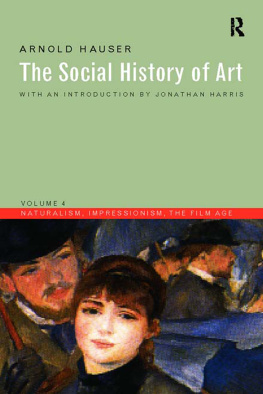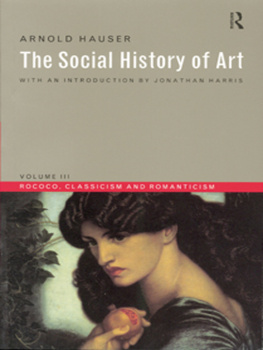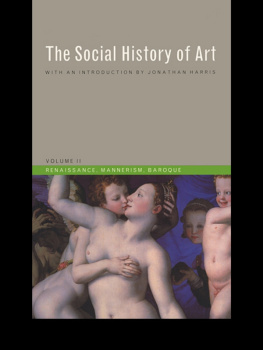Hauser Arnold - Social History of Art, Volume 4
Here you can read online Hauser Arnold - Social History of Art, Volume 4 full text of the book (entire story) in english for free. Download pdf and epub, get meaning, cover and reviews about this ebook. publisher: Routledge, genre: Art. Description of the work, (preface) as well as reviews are available. Best literature library LitArk.com created for fans of good reading and offers a wide selection of genres:
Romance novel
Science fiction
Adventure
Detective
Science
History
Home and family
Prose
Art
Politics
Computer
Non-fiction
Religion
Business
Children
Humor
Choose a favorite category and find really read worthwhile books. Enjoy immersion in the world of imagination, feel the emotions of the characters or learn something new for yourself, make an fascinating discovery.
- Book:Social History of Art, Volume 4
- Author:
- Publisher:Routledge
- Genre:
- Rating:5 / 5
- Favourites:Add to favourites
- Your mark:
- 100
- 1
- 2
- 3
- 4
- 5
Social History of Art, Volume 4: summary, description and annotation
We offer to read an annotation, description, summary or preface (depends on what the author of the book "Social History of Art, Volume 4" wrote himself). If you haven't found the necessary information about the book — write in the comments, we will try to find it.
Social History of Art, Volume 4 — read online for free the complete book (whole text) full work
Below is the text of the book, divided by pages. System saving the place of the last page read, allows you to conveniently read the book "Social History of Art, Volume 4" online for free, without having to search again every time where you left off. Put a bookmark, and you can go to the page where you finished reading at any time.
Font size:
Interval:
Bookmark:

VOLUME IV
As much a work of intellectual history as art history, Hausers work remains unparalleled in its scope as a study of the relations between the forces of social change and western art from its origins until the middle of the 20th century.
Johanna Drucker, Professor of Art History, State University of New York
Harriss introductions to each volume dealing with Hausers aims, principles, concepts and terms are extremely useful.... This edition should bring Hausers thought to the attention of a new generation of readers.
Whitney Davis, Professor of Art History, Northwestern University
First published in 1951 Arnold Hausers commanding work presents an account of the development and meaning of art from its origins in the Stone Age through to the Film Age. Exploring the interaction between art and society, Hauser effectively details social and historical movements and sketches the framework within which visual art is provided.
This new edition provides an excellent introduction to the work of Arnold Hauser. In his general introduction to The Social History of Art, Jonathan Harris assesses the importance of the work for contemporary art history and visual culture. In addition, an introduction to each volume provides a synopsis of Hausers narrative and serves as a critical guide to the text, identifying major themes, trends and arguments.
Arnold Hauser was born in Hungary and studied literature and the history of art at the universities of Budapest, Vienna, Berlin and Paris. In 1921 he returned to Berlin to study economics and sociology under Ernst Troeltsch. From 1923 to 1938 he lived in Vienna where he began work on The Social History of Art. He lived in London from 1938 until 1977, when he returned to his native Hungary. He died in Budapest in 1978.
Jonathan Harris is Senior Lecturer in Art History and Critical Theory at the University of Keele. He is the author of Federal Art and National Culture: The Politics of Identity in New Deal America (1995), co-author of Modernism in Dispute: Art Since The Forties (1993) and co-editor of Art in Modern Culture: An Anthology of Critical Texts (1992).
The Social History of Art
Arnold Hauser, with an introduction by Jonathan Harris
Volume I From Prehistoric Times to the Middle Ages
Volume II Renaissance, Mannerism, Baroque
Volume III Rococo, Classicism and Romanticism
Volume IV Naturalism, Impressionism, The Film Age
HISTORY OF ART
VOLUME IV
Naturalism, Impressionism, The Film Age
Arnold Hauser
with an introduction by Jonathan Harris

First published in two volumes 1951
Reprinted 1952
Second edition published in four volumes 1962
by Routledge
Reprinted four times
Reprinted 1989, 1995
by Routledge
2 Park Square, Milton Park, Abingdon, Oxon, 0X14 4RN
270 Madison Ave, New York NY 10016
Transferred to Digital Printing 2005
Third edition 1999
1951, 1962, 1999 The Estate of Arnold Hauser
Introductions 1999 Routledge
Translated in collaboration with the author by Stanley Godman
All rights reserved. No part of this book may be reprinted or reproduced or utilized in any form or by any electronic, mechanical, or other means, now known or hereafter invented, including photocopying and recording, or in any information storage or retrieval system, without permission in writing from the publishers.
British Library Cataloguing in Publication Data
A catalogue record for this book is available from the British Library
Library of Congress Cataloguing in Publication Data
A catalogue record for this book has been requested
ISBN 0415199484 (Vol. IV)
ISBN 041519945X (Vol. I)
ISBN 0415199468 (Vol. II)
ISBN 0415199476 (Vol. III)
ISBN 041521386X (Set)
Jonathan Harris
Contexts of reception
Arnold Hausers The Social History of Art first appeared in 1951, published in two volumes by Routledge and Kegan Paul. The text is over 500,000 words in length and presents an account of the development and meaning of art from its origins in the Stone Age to the Film Age of Hausers own time. Since its publication, Hausers history has been reprinted often, testament to its continuing popularity around the world over nearly a half-century. From the early 1960s the study has been reprinted six times in a four-volume series, most recently in 1995. In the period since the Second World War the discipline of art history has grown and diversified remarkably, both in terms of the definition and extent of its chosen objects of study, and its range of operative theories and methods of description, analyses and evaluation. Hausers account, from one reading clear in its affiliation to Marxist principles of historical and social understanding the centrality of class and class struggle, the social and cultural role of ideologies, and the determining influence of modes of economic production on art appeared at a moment when academic art history was still, in Britain at least, an elite and narrow concern, limited to a handful of university departments. Though Hausers intellectual background was thoroughly soaked in mid-European socio-cultural scholarship of a high order, only a relatively small portion of which was associated directly with Marxist or neo-Marxist perspectives, The Social History of Art arrived with the Cold War and its reputation quickly, and inevitably, suffered within the general backlash against political and intellectual Marxism which persisted within mainstream British and American society and culture until at least the 1960s and the birth of the so-called New Left. At this juncture, its first moment of reception, Hausers study, actually highly conventional in its definition and selection of arte-facts deemed worthy of consideration, was liable to be attacked and even vilified because of its declared theoretical and political orientation.
By the mid-1980s, a later version of Marxism, disseminated primarily through the development of academic media and cultural studies programmes, often interwoven with feminist, structuralist and psychoanalytic themes and perspectives, had gained (and regained) an intellectual respectability in rough and ironic proportion to the loss of its political significance in western Europe and the USA since the 1930s. Hausers study was liable to be seen in this second moment of reception as an interesting, if, on the whole, crude, antecedent within the development of a disciplinary specialism identified with contemporary academic art and cultural historians and theorists such as Edward Said, Raymond Williams, Pierre Bourdieu and T.J. Clark. By the 1980s, however, Hausers orthodox choice of objects of study, along with his unquestioned reliance on the largely unexamined category of art seen by many adherents of cultural studies as inherently reactionary meant that, once again, his history could be dismissed, this time primarily on the grounds of its both stated and tacit principles of selection. Yet The Social History of Art, whatever its uneven critical fortunes and continuing marginal place in most university courses, has remained an item, or an obstacle, to be read or at least dismissively referred to within the study of the history of art. Why should this be the case?
Font size:
Interval:
Bookmark:
Similar books «Social History of Art, Volume 4»
Look at similar books to Social History of Art, Volume 4. We have selected literature similar in name and meaning in the hope of providing readers with more options to find new, interesting, not yet read works.
Discussion, reviews of the book Social History of Art, Volume 4 and just readers' own opinions. Leave your comments, write what you think about the work, its meaning or the main characters. Specify what exactly you liked and what you didn't like, and why you think so.













